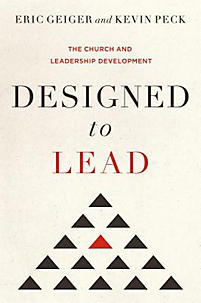Geiger, Eric and Kevin Peck; Designed to Lead: The Church and Leadership Development. Nashville, TN: B&H Publishing Group, 2016, pp. 234, $22.99, hardback.
Eric Geiger is a vice president of the Resources Division at LifeWay and a pastor of a local church in Tennessee. He has a doctorate in leadership from The Southern Baptist Theological Seminary and has authored or coauthored several books including the best-selling church leadership book, Simple Church. Kevin Peck, also with a doctorate in leadership from Southern Seminary, is the lead pastor at The Austin Stone Community Church in Texas. Peck also serves as the Director for Emerging Regions for the Acts 29 Network.
The authors open Designed to Lead by engaging this question: “Where is the leadership locus in your community?” and they seek to show that the local church ought to be a primary leadership locus in every community (p. 1). Their conviction is that the church is particularly commissioned and equipped to call and develop leaders in all spheres of life. The way that churches can systematically see that leaders are developed is by establishing constructs in the context of a leadership culture that grows out of a strong conviction that all people are called to leadership. It is along those lines that the book is divided into three sections: conviction, culture, and constructs.
Part one lays the foundation for a biblical and theological conviction for leadership development in the context of the local church. They ground their convictions in frequent exegeses of Scripture, affirmations of the priesthood of all believers and the imago Dei, and the counter-cultural nature of the Kingdom of God. They insist that apart from a robust biblical and theological conviction for leadership development, the congregation will not sense the urgency and empowerment that the Bible describes.
The second section defines church culture and describes how it is formed and changed. Geiger and Peck define culture, not as the “vibe” of a church, but as “what we truly believe and value over a sustained period of time” (p. 129). They show that the stated beliefs of a church do not necessarily find expression in behavior, and that managing the culture of a church is a function of the pastors (p. 130). Therefore, one of the roles of pastors in the church is to guide the “whole church to purity in doctrine and in deed” (p. 131). To do this, leaders must influence the foundational beliefs of a church and create avenues for their expression (p. 141).
The final section on constructs is likely what most readers are seeking when they pick up the book. The authors realize this and offer a thoughtful encouragement not to implement leadership constructs without first laying the groundwork of biblical convictions and establishing a culture that is prepared to embrace the construct. They advocate two constructs: the leadership pipeline and the leadership pathway (p. 186). The leadership pipeline is a big-picture layout of leadership roles focusing on the congregation as a whole, and a leadership pathway is a description of role-specific competencies for each individual to pursue.
The book has much to commend. The authors consistently call the readers back to the centrality of the gospel for the life and ministry of the church and take frequent stops to remind the reader that leadership development is not the primary function of the church—worshiping the Triune God is primary. Another strength of the book is how the authors envision that the leaders developed by the church are called to bless and serve and influence spheres of life beyond the church’s doors. They speak often of this calling, stating that “up to 70 percent of leadership is completely transferable to any domain” (p. 177).
I believe the authors achieve their purposes for the book in chapter 8 entitled “Pipelines and Pathways.” This single chapter contains the practical implementation of their argument. They explain that the church must do more than envision leadership and discipleship; the church “must also provide steps or opportunities for people to mature and develop as leaders” (p. 181). The authors are effective in clearly presenting a baseline plan for the implementation of leadership constructs. One principle that is emphasized is the necessity of written competencies that pastors desire to see developed in individuals in ministry positions. It is important that each level of leadership has competencies that are specific to that role (p. 195). This principle alone could impact the leadership culture of a church because each person has clarity regarding responsibilities and has a defined path for growth.
However, the book is not without its weaknesses, perhaps the chief being the confusing distinction between how the authors use the terms leadership and discipleship. Early in the book they state, “If you are His, you are designed to lead” (p. 4), but it is not until chapter seven that they describe the difference between general discipleship and leadership development. To be fair, their distinction is legitimate, for they write that leadership development is a subset of discipleship, or “advanced discipleship” (p. 153). This lack of clarity on the front end leaves the reader confused throughout most of the book as to what kind of leadership is being advocated and for which members of the congregation.
The authors spend the first three-quarters of the book laying the theological and ecclesiological foundations for implementing leadership development constructs; however, when the reader finally gets to the constructs section, there is a desire for more—more application, more troubleshooting, more examples. Beyond that, the reader wonders how these forms of constructs avoid painting the picture of the church as a corporation rather than the church as a body (1 Corinthians 12:27). The authors recognize this tension: “You don’t want to send the signal that success is progression through the pipeline. The goal of the pipeline is development, not progression” (p. 197). Nevertheless, church leaders seeking to implement Geiger and Peck’s model will have to wrestle with this “climbing the corporate ladder” mentality.
From start to finish, the book is a practical and accessible tool for helping men and women grow in leadership ability both inside and outside the church. This book is a welcome contribution to the field of church leadership because it advocates a theologically grounded construct for leadership development. There is a fear that leadership books simply offer another gimmicky framework that can work for a short time, only to be replaced by the next trend in leadership education—everybody becomes confused, and perhaps cynical. This is not that sort of book. This book is written by pastors with significant influence and experience in the development of leaders, and it is intended to serve as a guide for other pastors to incorporate the constructs in their own churches. Geiger and Peck succeed in creating an accessible entry point into the area of leadership and coaching which I expect pastors and church leaders will read and discuss together. Church leaders and students from all denominations ought to read and engage with this book because of its high esteem of the local church for developing leaders who will serve both within the church and without.
Garrett Walden
The Southern Baptist Theological Seminary
Louisville, KY





